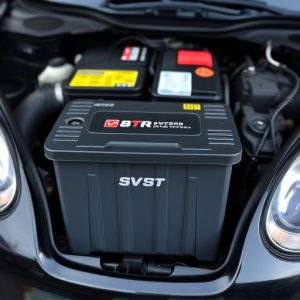Optimizing Marine Battery Life: Care for Lead-Acid, AGM, and Lithium Types
Marine batteries, critical for any vessel's electrical operations, come primarily in lead-acid (flooded, AGM, or gel cell) and lithium-ion/lithium-iron variants. Lead-acid batteries require regular water top-offs, terminal cleaning, and secure mounting to ensure longevity and performance. AGM a…….

Marine batteries, critical for any vessel's electrical operations, come primarily in lead-acid (flooded, AGM, or gel cell) and lithium-ion/lithium-iron variants. Lead-acid batteries require regular water top-offs, terminal cleaning, and secure mounting to ensure longevity and performance. AGM and gel cell types are maintenance-friendly with longer lifespans but need careful charging, especially using a smart charger, and attention to terminal cleanliness and proper storage when not in use. Proper care is key for all marine batteries to prevent overcharging, sulfation, and degradation. For lead-acid batteries, consistent water checking, terminal maintenance, and charging at the correct rate are essential. AGM batteries should be monitored with a voltmeter to avoid deep discharges, stored in controlled temperatures, and charged with compatible devices to ensure their durability and performance. AGMs also need electrolyte levels maintained with distilled water. Lithium-ion and lithium-iron marine batteries offer superior performance with higher energy density but demand careful management to avoid deep discharges and extreme temperature exposure. Regular checks for damage, monitoring charging cycles, and using a suitable charge controller are necessary to maintain their longevity and efficiency. In summary, maintaining any boat battery type involves consistent care tailored to the specific chemistry, ensuring safety, reliability, and optimal operation on the water.
When embarking on the high seas, a reliable marine battery is your vessel’s beating heart. This article navigates through the diverse types of marine batteries—lead-acid, AGM, lithium-ion, and lithium-iron—offering tailored maintenance advice to ensure they perform at their peak. From understanding the unique needs of each battery type to actionable tips for longevity, learn how to maintain your boat battery for optimal performance, enhancing both safety and reliability on your marine adventures.
- Understanding Your Boat Battery Types and Their Maintenance Needs
- Lead-Acid Boat Batteries: Care and Maintenance for Optimal Performance
- AGM (Absorbent Glass Mat) Boat Batteries: Tips for Maintaining Power and Longevity
- Lithium-Ion and Lithium-Iron Boat Batteries: Ensuring Peak Efficiency Through Proper Maintenance
Understanding Your Boat Battery Types and Their Maintenance Needs

When it comes to maintaining different marine batteries, understanding the type of battery you have on your vessel is crucial for their longevity and optimal performance. Marine batteries primarily fall into two categories: lead-acid and absorbent glass mat (AGM) or gel cell batteries. Lead-acid batteries, including traditional flooded lead-acid types, have been the standard for many years due to their reliability and cost-effectiveness. They contain a liquid electrolyte that needs regular monitoring and maintenance, such as checking the water levels in each cell and ensuring proper charging after use. Regular cleaning of terminals and secure mounting to prevent movement during operation are also essential practices for these batteries.
On the other hand, AGM and gel cell batteries represent advanced lead-acid technologies that offer spill-proof construction and longer lifespans. These sealed batteries require less maintenance than traditional lead-acid types but still necessitate attention to ensure their longevity. It’s important to understand that while they don’t need water top-ups, they are sensitive to overcharging, so using a smart battery charger with an AGM or gel setting is recommended. Additionally, keeping the terminals clean and ensuring the battery is stored in a suitable environment when not in use will help maintain its performance and extend its life. Regular charging and careful handling of these batteries can mitigate the risk of sulfation, a common issue that affects their capacity to hold a charge over time. Proper maintenance of your marine battery, whether it’s a traditional lead-acid or an advanced AGM or gel cell, is essential for safe and reliable operation on the water. Boat owners should familiarize themselves with the specific needs of their battery type to ensure they provide the right care.
Lead-Acid Boat Batteries: Care and Maintenance for Optimal Performance

When it comes to maintaining lead-acid boat batteries for optimal performance, there are several key practices to adhere to. Regularly check the water levels in each cell; distilled water should be used to replace any that has evaporated or been lost due to charging. This is crucial for ensuring the electrolyte concentration remains at an ideal level for battery health and longevity. Additionally, ensure the battery terminals are clean and free of corrosion, as this can impede electrical connectivity and reduce efficiency. Frequent charging with the correct ampere rate is also essential; avoid overcharging as it can shorten the lifespan of the battery. It’s important to charge the battery consistently, especially before long periods of non-use, to keep the active materials in a charged state, preventing sulfation, which can impair battery performance. Regular equalization charging is recommended to maintain the plates evenly, as this type of battery can develop a memory effect, where one portion of the plate may become set at a lower state of charge than the rest. Proper ventilation around the battery is necessary to prevent gas accumulation, which can occur during charging and discharging cycles. By following these maintenance tips, boat owners can maximize the performance and lifespan of their lead-acid batteries, ensuring they remain reliable power sources for all their maritime adventures.
AGM (Absorbent Glass Mat) Boat Batteries: Tips for Maintaining Power and Longevity

AGM (Absorbent Glass Mat) boat batteries are a popular choice for maritime enthusiasts due to their robust construction and reliable performance. To maintain the power and longevity of your AGM battery, it’s crucial to follow a routine that ensures optimal function. Regularly check the battery’s charge level with a voltmeter before and after each outing to prevent over-discharging. Ensure the battery is stored in a cool, dry place, away from direct sunlight and extreme temperatures, as these conditions can degrade the battery’s performance over time. Proper charging techniques are essential; use a charger that matches the battery’s specifications, and avoid fast chargers that can harm the AGM’s internal structure. Additionally, keep the terminals clean and free of corrosion by periodically washing them with a baking soda solution and then rinsing with clean water. Regular maintenance, such as topping off the water levels in flooded-type AGMs if necessary, will also help maintain peak performance. By adhering to these practices, you can extend the lifespan of your AGM boat battery and ensure it remains a dependable source of power on the water.
Lithium-Ion and Lithium-Iron Boat Batteries: Ensuring Peak Efficiency Through Proper Maintenance

Maintaining peak efficiency in lithium-ion and lithium-iron boat batteries requires a comprehensive approach to care and management. Unlike traditional lead-acid batteries, these advanced lithium counterparts offer higher energy density and longer life spans, provided they are maintained correctly. Regular charging and discharging cycles should be monitored to ensure the battery operates within its optimal range. Lithium-ion and lithium-iron boat batteries thrive under consistent use but should not be deeply discharged frequently, as this can degrade their performance over time. It’s crucial to utilize a charge controller that suits the specific battery type to prevent overcharging or undercharging, which can impair battery health. Additionally, storing these batteries at a partial charge, avoiding full depletion or complete recharge to full capacity, helps maintain their longevity. Temperature control is another critical factor; keeping them within the recommended range can protect against excessive heat or cold, both of which can diminish battery efficiency. Regular inspections for any physical damage or corrosion on terminals and connectors are also essential for maintaining peak performance. By adhering to these maintenance practices, boat owners can ensure their lithium-ion and lithium-iron batteries remain reliable and efficient power sources for their maritime adventures.
When it comes to maintaining marine batteries, whether you’re a seasoned captain or a novice navigator, understanding the specific needs of each battery type is key to ensuring your vessel’s power supply remains reliable and robust. This article has demystified the maintenance of lead-acid, AGM, lithium-ion, and lithium-iron boat batteries, offering actionable advice for each. By following the care and maintenance guidelines outlined, you can extend the lifespan of your batteries and keep them operating at peak efficiency. Regular checks, proper charging, and proactive upkeep are crucial components in safeguarding your investment on the water. With these practices in hand, you’ll set sail with confidence, knowing that your boat battery will be a steadfast companion on all your maritime adventures.







